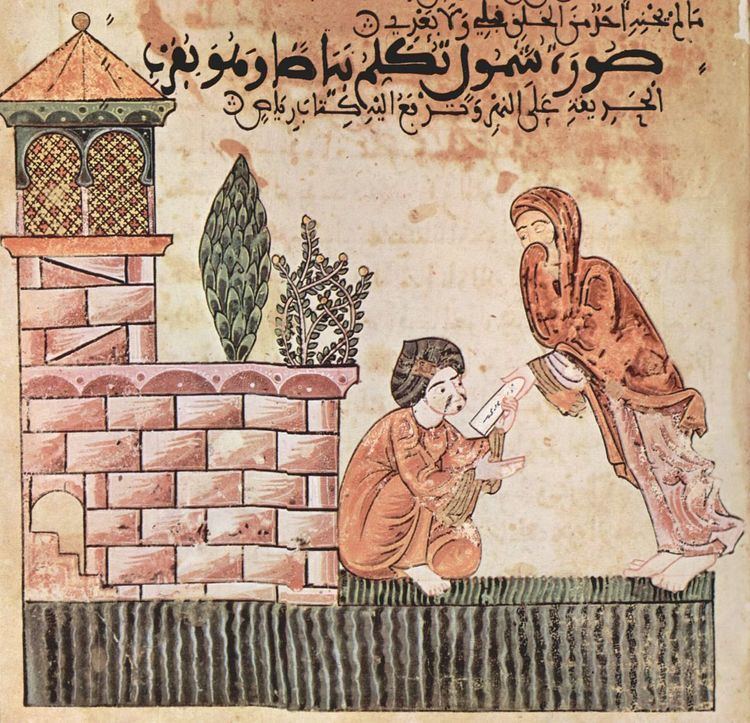 | ||
Moroccan literature is a literature written in (Moroccan) Arabic, Berber, French or Spanish and of course particularly by people of Morocco, but also of Al-Andalus.
Contents
1000 - 1500
Moroccan literature saw its first flowering in the period of the Almoravid dynasty (1040–1147). In this period two writers stand out: Ayyad ben Moussa and Ibn Bajja and, in al-Andalus, Al-Tutili, Ibn Baqi, Ibn Khafaja and Ibn Sahl. An impression of a number of great poets of the period is given in anthologies and biographies like Kharidat al Qsar, Al Mutrib and Mujam as-Sifr. From 1086 Morocco and Al-Andalus, with its rich tradition from the Umayyads, formed one state and the Almoravid sultans stimulated culture in their courts and in the country. Ibn Bassam dedicated his anthology Dhakhira fî mahâsin ahl al-Gazira to Abu-Bakr Ibn-Umar and al-Fath ibn Khaqan his Qala-id al-Iqyan to Yusuf ibn Tashfin. The early Almoravid movement had itself been influenced by the writings of Abu Imran al-Fasi.
Under the Almohad dynasty (1147–1269) Morocco experienced another period of prosperity and brilliance of learning. The Almohad built the Marrakech Koutoubia Mosque, which accommodated no fewer than 25,000 people, but was also famed for its books, manuscripts, libraries and book shops, which gave it its name; the first book bazaar in history. The Almohad sultan Abu Yaqub Yusuf had a great love for collecting books. He founded a great private library, which was eventually moved to the kasbah of Marrakech and turned into a public library. Under the Almohads, the sovereigns encouraged the construction of schools and sponsored scholars of every sort. Ibn Rushd (Averroes), Ibn Tufail, Ibn Zuhr, Ibn al-Abbar, Ibn Amira and many more poets, philosophers and scholars found sanctuary and served the Almohad rulers.
During the reign of the Marinid dynasty (1215–1420) it was especially Sultan Abu Inan Faris (r. 1349-1358) who stimulated literature. He built the Bou Inania Madrasa. At his invitation the icon of Moroccan literature Ibn Batuta returned to settle down in the city of Fez and write his Rihla or travelogue in cooperation with Ibn Juzayy. Abdelaziz al-Malzuzi (-1298) and Malik ibn al-Murahhal (1207–1300) are considered as the two greatest poets of the Marinid era. Historiographers were, among many others, Ismail ibn al-Ahmar and Ibn Idhari. Poets of Al-Andalus, like Ibn Abbad al-Rundi (1333–1390) and Salih ben Sharif al-Rundi (1204–1285) settled in Morocco, often forced by the political situation of the Nasrid kingdom. Both Ibn al-Khatib (1313–1374) and Ibn Zamrak, vizirs and poets whose poems can be read on the walls of the Alhambra, found shelter here. The heritage left by the literature of this time that saw the flowering of Al-Andalus and the rise of three Berber dynasties had its impact on Moroccan literature throughout the following centuries.
University of Fez
From the beginning of the 12th century the University of Fez played an important rule in the development of Moroccan literature. Among the scholars who studied and taught there were Ibn Khaldoun, Ibn al-Khatib, Al-Bannani, al-Bitruji, Ibn Hirzihim (Sidi Harazim) and Al-Wazzan (Leo Africanus). The writings of Sufi leaders have played an important role in Moroccan literature from this early period (e.g. Abu-l-Hassan ash-Shadhili and al-Jazouli) until now (e.g. Muhammad ibn al-Habib).
1500 - 1900
The possession of manuscripts of famous writers remained the pride of courts and zawiyas throughout the history of Morocco until the modern times. The great Saadian ruler Ahmed al-Mansour (r.1578–1603) was a poet king. Poets of his court were Ahmad Ibn al-Qadi, Abd al-Aziz al-Fishtali. Ahmed Mohammed al-Maqqari lived during the reign of his sons. The Saadi Dynasty contributed greatly to the library of the Taroudannt. Another library established in time that was that of Tamegroute. A large part of it remains today. By a strange coincidence the complete library of another Saadian ruler has also been transmitted to us to the present day. Due to circumstances in a civil war the sultan Zidan (r.1603–1627) had his complete collection transferred to a ship. The commander of the ship stole the ship and brought it to Spain where the collection was transmitted to El Escorial.
Some of the main genres differed from what was prominent in European countries:
Famous Moroccan poets of this period were Abderrahman El Majdoub, Al-Masfiwi, Muhammad Awzal and Hemmou Talb.
Modern times
Three generations of writers especially shaped 20th century Moroccan literature. The first was the generation that lived and wrote during the Protectorate (1912–56), its most important representative being Mohammed Ben Brahim (1897–1955). The second generation was the one that played an important role in the transition to independence with writers like Abdelkrim Ghallab (1919–2006), Allal al-Fassi (1910–1974) and Mohammed al-Mokhtar Soussi (1900–1963). The third generation is that of writers of the sixties. Moroccan literature then flourished with writers such as Mohamed Choukri, Driss Chraïbi, Mohamed Zafzaf and Driss El Khouri. Those writers were an important influence the many Moroccan novelists, poets and playwrights that were still to come.
During the 1950s and 1960s, Morocco was also a refuge for writers from abroad as Paul Bowles, Tennessee Williams, Brion Gysin, William S. Burroughs and Jack Kerouac.
In 1966 a group of Moroccan writers founded a magazine called Souffles (Breaths) that was prohibited by the government in 1972 but gave impetus to the poetry and modern romantic works of many Moroccan writers.
List of Moroccan writers
Template:The number of Moroccan writers increased dramatically after Morocco's independence.
